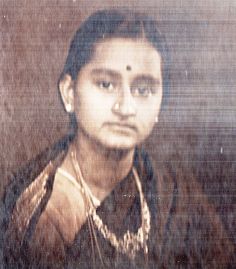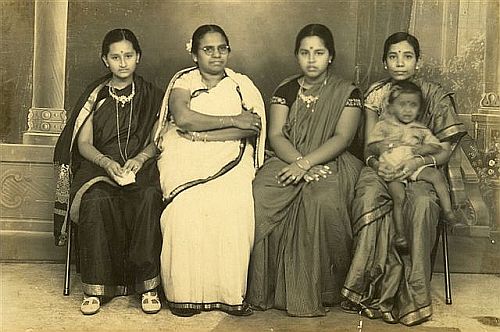Latest Contributions
Read More Contributions
Chapter 2: Memories of Erode
Category:
Tags:

Visalam Balasubramanian was born in Pollachi, on May 17, 1925. She was the second of three children. Having lost her mother at about age 2, she grew up with her siblings, cared for by her father who lived out his life as a widower in Erode. She was married in 1939. Her adult life revolved entirely around her husband and four children. She was a gifted vocalist in the Carnatic tradition, and very well read. Visalam passed away on February 20, 2005.
Editor’s note: This is Part 2 of her memoirs, which have been edited for this website. Part 1 is available here. Kamakshi Balasubramanian, her daughter, has added some parenthetical explanatory notes in italics.
I think I will write about the town Erode and life in general then.

L to R: Visalam, Friend, Gowri (older sister), Sakku (friend) C. 193x
It was a dusty town with open drains. Until 1932-33, there were only two three motor cars but there were omnibuses.
My grandfather never lived in rented houses in his life. He always bought a house whenever he moved from one place to another. Our house was on one of the main roads. Early every morning, workers from the municipality came and washed away the drains on the roads. Then another batch swept the roads and a lorry went behind them sprinkling water.
Elections for the municipal office were held, and we have attended some of the functions in connection with the new chairman assuming office or a commissioner getting transferred or some inaugural celebration of park, opening of a hospital ward, etc. Even in those days, people used to talk of corruption, favouritism and the like.
During the term of one chairman, a Muslim, he converted a few Muslim burial places that were right in the middle of busy thoroughfares and residential localities into parks by planting trees, placing some cement benches and putting up either a fence or trellis wall, and naming them after a European district collector or executive engineer.
He closed the other public parks on Fridays to men, declaring it Ladies Day. He made the main bazaar street one-way to all traffic. He was elected chairman three times. Two terms he held continuously, and once with a break. All the time he was there all the rules were strictly observed. But people used to talk of him slightingly, saying that he acquired property. His name was Sheikh Dawood. He was conferred the title of Khan Saheb.
Long before that, the municipality had constructed four huge tanks at the highest point of town. They were set in a picturesque architecture of four towers, paths, lovely steps, broad at some levels, wide and curving at some or uniform and symmetrically parallel at others, with decorative, sloping parapets, dotted with masonry flower pots, lotus tanks in an area of about four square miles for supplying drinking water to the town from river Cauvery that skirts the town on the northern side. There were bowers, nursery, enclosed areas to rest, away from the sun and rain, with fixed wrought iron benches.
There was a central library with deep verandahs running on all the four sides, where one could read books or periodicals undisturbed. It was also built on an elevation so that the view was beautiful. Attendants were always present, trimming the crotons, pruning, planting, watering as well as preventing people from walking on or trampling the grassy slopes or plucking the flowers.
It was a library and free reading room.
There were some natural ponds and rocks. There were two lotus tanks, one with a fountain in the middle and white ducks placed in four places inside. I don't know what they were made of\; may be they were of refined mortar. I know they looked new even after forty years of installation. It had a ring road running the circumference of the park.
There were living quarters for the superintendent and some of the workers. An Anglo-Indian old man, McDonald, lived there with his wife, son, and daughter-in-law. A large area was always maintained and looked after for playing football, basketball, with the goal posts and high ring for the basket there. There were some parallel bars and other things for gymnastics. There were see-saws and swings for youngsters in another grassy enclosure. It was a lovely beautiful park. Originally, it was constructed at the time of one Srinivasa Mudaliar and named after him.
There was a small Hanuman temple in one of the gradients, and a platform with a Muslim prayer wall where Tipu Sultan was said to have conducted prayers near the main reservoir at the top and it was called பேச்சிப்பாறை (Pechiparai). When Sheikh Dawood succeeded Mudaliar, he renamed this "Peoples' Park" and added a small zoo to it. I think the park was the boundary of the town municipal limits on that side.
There was another big playground and football field belonging to the London Mission (popular name for the London Mission Society established in Erode in 1936). They had a big church, hospital and school. That hospital was exclusively for women. Dr. H.M. Pollard, one of the senior doctors there, was respected, admired and feared. She attended on me and delivered Savithri (Visalam's first-born, daughter) in the year she retired from service and left for England.
That road and compound were named after Rev. Brough, whom I remember as a genial man. His wife was a kind woman. After him, Rev. H.A. Popley took over. He used to don வேஷ்டி அங்கவஸ்த்ரம் (veshti angavastram\; dhoti and upper cloth) and speak on திருக்குறள் (Tirukkural) in Tamil.
There were three Mariamman temples, one பெரியமாரியம்மன் கோயில் (Periya Mariamman Koil, Great Mariamman Temple) at the western point, நடு மாரியம்மன் கோயில் (Nadu Mariamman Koil, Middle Mariamman Koil) right in the middle, and சின்ன மாரியம்மன் கோயில் (Chinna Mariamman Koil, Little Mariamman Koil) at the eastern part. An annual celebration lasting fifteen days with தேர் (ther, the ceremonial temple car to take deities on procession through the streets) for four days towards the end was held in பங்குனி (Panguni, the last of the twelve-month Tamil calendar). This event was piously and strictly observed by all sections of the people.
Boundaries of Erode in those days: On the East, it extended up to one கருமாதி கருப்பண்ணன் கோயில் (Karumathi Karuppannan Temple) beyond the railway line. On the South, it ended up near Kollumpalayan, bordering on the Railway Colony built by the South Indian Railway. On the West, it was இடயன்காட்டு வாசல் (Idayankattu vassal). Later it got extended even beyond திண்டல் மலை (Thindal Malai). On the North, it was the Municipal Park. As children, we have walked (our daily evening constitutional routine!) close to those boundaries. So, I know the roads and routes to Coimbatore, Trichy, Palani from Erode.
I could write a lot more about those times, about the townspeople, some of the customs, the regular beggars who rested in dilapidated, disused buildings, arches or under trees, who were known by their names, but I don't feel the need to do it. If Kartik (Visalam's grandson) would want to know anything, I could tell him. Otherwise, I think I will concentrate more upon my own family life after writing about the anti-Brahmin movement that had its home in Erode.
On second thoughts, I will do the anti-Brahmin movement separately because it was very much there during my father's time, and he was finding methods and ways to beat it.
My father was one of the honorary magistrates of the bench court that used to sit twice a week. He was the only Brahmin. Of the others, I remember one Christian lawyer and another Christian lady doctor, Anna Devairakkam Rajanayakam, whom we knew very well. Her husband, Mr. Rajanayakam, was a teacher by profession. Very quiet, studious, he was liked and respected. His hobby was assembling and listening to home radio. I don't know if Ham radio was known in those days. He had three children by his first wife. When she died, he married her friend, Anna.
Incidentally, it was he who told me of the outbreak of the World War II, even before it came over All India Radio. I came home, told my father (and uncle who happened to be there), and he sent messages to the business/merchant community.
There was no electricity in Erode till 1932-33. Even after the adjoining places got electrified there was some disagreement between the GEC (General Electric Company) and the municipality, and it was held up.
When my father learnt that the electric wires were going within 30-40 miles of Erode, he spent his own money, got the poles erected, wires drawn and brought current to illuminate the Shiva temple. The entire expenditure was his. The light on top of the கோபுரம் (gopurm, temple tower) was to be on all nights except on full moon days. Lights on the four corners were to be on between 6.00 p.m. and 9.00 p.m. It was one of my father's first big works of public interest combined with தர்மம் (darma piety) that I remember.
Go to Part 3
______________________________________
© Kamakshi Balasubramanian 2015
Editor's note: I approve all comments written by people. The purpose of the approval process is to prevent unwanted comments, inserted by software robots, which have nothing to do with the story.
Comments
Great grand son of Sheik Dawood
About Khan Saheb Sheik Dawood
Please send me an email
Add new comment